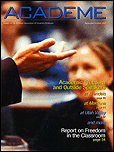How to Diversify the Faculty
Institutions must get beyond the myths and adopt new hiring practices if they want to add significant numbers of minority group members to the faculty
In this article, Daryl Smith, professor of education and psychology at the Claremont Graduate University, identifies the prevailing ideas – myths – about diversifying the faculty that impede the search process, along with strategies that institutions might consider as they explore what diversity can contribute to higher education.
We’ve all heard the refrain that most colleges and universities fail to diversify their faculties because so few scholars of color earn doctorates. A parallel claim is that members of under-represented minority groups who seek academic posts are in such great demand that they can pick and choose among multiple offers.
Despite the abysmal job market, many people also believe that the academy’s commitment to diversity, combined with a limited supply of minority-group scholars, has created a bidding war that favors faculty of color over white men. Non-elite institutions that accept this argument think they are notnrich, well-located, or prestigious enough to attract the few candidates who are in such high demand. “Although a concerted effort has been made,” explains one prestigious research institution in a typical plaint, “small candidate pools and intense competition between top universities has made growth in [minority] faculty numbers extremely difficult.”
And yet many faculty and administrators of color do not see themselves as the beneficiaries of bidding wars. On the contrary, they say, minority scholars have trouble landing tenure-track jobs; like their white colleagues, faculty of color suffer not only from the poor academic labor market, but also from the traditional hiring practices of most institutions
Access the full article at JSTOR.




